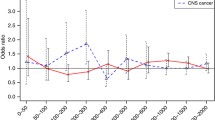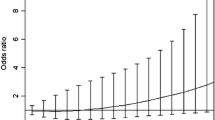Abstract
Background: In a population-based case–control study we examined the association between residential exposure to overhead high-voltage lines and testicular cancer. Methods: We recorded the residential biography of cases with testicular cancer identified by the Hamburg Cancer Registry and of controls that were randomly selected from the mandatory registry of residents in Hamburg. The study included 145 incident cases between 15 and 69 years of age, diagnosed between 1995 and 1997, and 313 controls, matched for age in 5-year strata. In model A, exposure was defined by distance (ever vs never). Model B took into account residence time and the inverse distance from the nearest high-voltage line. It distinguished between low and high exposure, the never exposed persons serving as a reference group. Odds ratios (ORs) and corresponding 95% confidence intervals (CIs) were calculated by unconditional logistic regression. For men below the age of 40 years and men aged 40 years and over separate analyses were carried out. Results: Within a corridor of 100 m the prevalence of exposure to high-voltage lines in Hamburg was 6.9% in cases and 5.8% in controls (OR=1.3; 95% CI=0.56–2.80). In the more complex model B we found an OR of 1.2 (95% CI=0.60–2.47) for low exposure and 1.7 (95% CI=0.91–3.32) for high exposure. Younger men show slightly increased risks in both models. Conclusions: In all, residential exposure to high-voltage lines did not seem to be a major risk factor for testicular cancer in our study. Yet, the fact that risks for men below the age of 40 years were slightly increased in both exposure models deserves further attention.

Similar content being viewed by others
References
Baubehörde (1997) Amt für Geoinformation und Vermessung. Digitale Stadtkarte Hamburg
Baumgardt-Elms C, Ahrens W, Bromen K, Boikat U, Stang A, Jahn I, Stegmaier C, Jöckel KH (2002) Testicular cancer and electromagnetic fields (EMF) in the workplace: results of a population-based case–control study in Germany. Cancer Causes Control 13:895–902
Bergstrom R, Adami HO, Möhner M, Zatonski W, Storm H, Ekbom A, Steinar T, Teppo L, Akre O, Hakulinen T (1996) Increase in testicular cancer incidence in six European countries: a birth cohort phenomenon. J Natl Cancer Inst 88:727–733
Boikat U, Manikowsky S (1996) Vorbeugung beim Wohnungsbau gegen elektromagnetische Felder von Hochspannungsleitungen—Grundlagen der Risikobewertung Gesundheitswesen 58:147–153
Bokemeyer C, Harstrick A, Schoffski P, Schmoll HJ, Keimzelltumoren des Hodens PH (1992) Epidemiologische und ätiologische Aspekte. Dtsch Med Wochenschr 117:1532
Buetow SA (1995) Epidemiology of testicular cancer. Epidemiol Rev 17:433–449
Coleman MP, Estève J, Damiecki P, Arslan A, Renard H (1993) Trends in cancer incidence and mortality, 1st edn, vol 121. International Agency for Research on Cancer (IARC), Lyon, pp 521–542
Davis RL, Mostofi FK (1993) Cluster of testicular cancer in police officers exposed to hand-held radar. Am J Ind Med 24:231–233
Erren TC (1996) Association between exposure to pulsed electromagnetic fields and cancer in electric utility workers in Quebec, Canada, and France. Am J Epidemiol 143:841
Ferlay J, Bray F, Sankila R, Parkin DM (1999) EUCAN: cancer incidence, mortality and prevalence in the European Union 1995, version 2.0. IARC CancerBase No. 4. IARC Press, Lyon
Fews AP, Henshaw DL, Keitch PA, Close JJ, Wilding RJ (1999) Increased exposure to pollutant aerosols under overhead high-voltage lines. Int J Radiat Biol 75:1505–1521
Finkelstein MM (1998) Cancer incidence among Ontario police officers. Am J Ind Med 34:157–162
Floderus B, Stenlund C, Persson T (1999) Occupational magnetic field exposure and site-specific cancer incidence: a Swedish cohort study. Cancer Causes Control 10:323–332
Forman D, Gallagher R, Møller H, Swerdlow TJ (1990) Aetiology and epidemiology of testicular cancer: report of consensus group. In: Anonymous prostate cancer and testicular cancer. Wiley-Liss, pp 245–253
Garland FC, Gorham ED, Garland CF, Ducatman AM (1988) Testicular cancer in US Navy personnel. Am J Epidemiol 127:411–414
Hardell L, Holmberg B, Malker H, Paulsson LE (1995) Exposure to extremely low frequency electromagnetic fields and the risk of malignant diseases—an evaluation of epidemiological and experimental findings. Eur J Cancer Prev 4 [Suppl 1]:103–107
Hardell L, Nasman A, Ohlson CG, Fredrikson M (1998) Case–control study on risk factors for testicular cancer. Int J Oncol 13:1299–1303
Hayes RB, Brown LM, Pottern LM, Gomez M, Kardaun JW, Hoover RN, et al (1990) Occupation and risk for testicular cancer: a case–control study. Int J Epidemiol 19:825–831
Henshaw DL (1997) Electromagnetic field exposure and lung cancer. Am J Epidemiol 146:366
International Agency for Research on Cancer (IARC) (2002) IARC monographs on the evaluation of carcinogenic risks to humans, vol 80, non-ionizing radiation, part 1: Static and extremely low-frequency (ELF) electric and magnetic fields, IARC Press, Lyon, France
Jöckel KH, Babitsch B, Bellach BM, Bloomfield K, Hoffmeyer-Zlotnik J, Winkler J (1998) Empfehlungen der Arbeitsgruppe “Epidemiologische Methoden” in der Deutschen Arbeitsgemeinschaft Epidemiologie der Gesellschaft für Medizinische Informatik, Biometrie und Epidemiologie (GMDS) und der Deutschen Gesellschaft für Sozialmedizin und Prävention (DGSMP) zur Messung und Quantifizierung soziodemographischer Merkmale in epidemiologischen Studien. In: Ahrens W, Bellach BM, Jöckel KH (eds) Messung soziodemographischer Merkmale in der Epidemiologie. RKI Schriften 1/09, MMV-Verlag, München
Knoke JD, Gray GC, Garland FC (1998) Testicular cancer and Persian Gulf War service. Epidemiology 9:648–653
Merzenich H, Ahrens W, Stang A, Baumgardt-Elms C, Jahn I, Stegmaier C, Jöckel KH (2000) Sorting the hype from the facts in testicular cancer: is testicular cancer related to trauma? J Urol 164:2143–2144
Møller H (1993) Clues to the aetiology of testicular germ cell tumours from descriptive epidemiology. Eur Urol 23:8–15
National Institutes of Environmental Health Sciences (NIEHS), US National Institutes of Health (1998) Assessment of health effects from exposure to power-line frequency electric and magnetic fields: working group report, NIH publication no. 98-3981
Pearce N, Sheppard RA, Howard JK, Fraser J, Lilley BM (1987) Time trends and occupational differences in cancer of the testis in New Zealand. Cancer 59:1677–1682
Pearce N, Reif J, Fraser J (1989) Case–control studies of cancer in New Zealand electrical workers. Int J Epidemiol 18:55–59
Prener A, Hsieh C, Engholm G, Trichopoulos D, Jensen OM (1992) Birth order and risk of testicular cancer. Cancer Causes Control 3:265–272
Ryder SJ, Crawford PI, Pethybridge RJ (1997) Is testicular cancer an occupational disease? A case–control study of Royal Naval personnel. J R Nav Med Serv 83:130–146
Schottenfeld D (1996) Testicular cancer. In: Schottenfeld D, Fraumeni JFJ (eds) Cancer epidemiology and prevention, 2nd edn. Oxford University Press, New York, pp 1207–1219
Schümann M, Baumgardt-Elms C, Berger J, Hartmann R, Haartje U, Burkhardt N (2001) Leukämien bei Kindern und Jugendlichen in Hamburg (1980–1995). Auswertungen zur Entwicklung der Inzidenz und regionalen Verteilung. P. Lang Verlag, Frankfurt a.M.
Schüz J, Grigat J-P, Störmer B, Rippin G, Brinkmann K, Michaelis J (2000) Extremely low frequency magnetic fields in residences in Germany. Distribution of measurements, comparison of two methods for assessing exposure, and predictors for the occurrence of magnetic fields above background level. Radiat Environ Biophys 39:233–240
SPSS for Windows (1989–1999) Release 10.0.5 (27 November 1999) Standard version, SPSS
Stang A, Ahrens W, Bromen K, Baumgardt-Elms C, Jahn I, Stegmaier C, Krege S, Jöckel KH (2001) Undescended testis and the risk of testicular cancer: importance of source and classification of exposure information. Int J Epidemiol 30:1050–1056
Stang A, Jöckel KH, Baumgardt-Elms C, Ahrens W (2003) Firefighting and risk of testicular cancer: results from a German population-based case–control study. Am J Ind Med 43:291–294
Stenlund C, Floderus B (1997) Occupational exposure to magnetic fields in relation to male breast cancer and testicular cancer: a Swedish case–control study. Cancer Causes Control 8:184–191
Swerdlow AJ, Skeet RG (1988) Occupational associations of testicular cancer in south east England. Br J Ind Med 45:225–230
Swerdlow AJ, Douglas AJ, Huttly SR, Smith PG (1991) Cancer of the testis, socioeconomic status, and occupation. Br J Ind Med 48:670–674
Törnquist S, Norell S, Ahlboom A, Knave B (1986) Cancer in the electric power industry. BMJ 43:212–213
Tynes T, Andersen A, Langmark F (1992) Incidence of cancer in Norwegian workers potentially exposed to electromagnetic fields. Am J Epidemiol 136:81–88
United Kingdom Testicular Cancer Study Group (1994) Social, behavioural and medical factors in the aetiology of testicular cancer: results from the UK study. UK Testicular Cancer Study Group. Br J Cancer 70:513
Van den Eeden SK, Weiss NS, Strader CH, Daling JR (1991) Occupation and the occurrence of testicular cancer. Am J Ind Med 19:327–337
Verkasalo PK, Pukkala E, Kaprio J, Heikkila KV, Koskenvuo M (1996) Magnetic fields of overhead high-voltage lines and risk of cancer in Finnish adults: nationwide cohort study (see comments). BMJ 313:1047–1051
Wertheimer N, Leeper E (1979) Electrical wiring configurations and childhood cancer. Am J Epidemiol 109:273–284
Acknowledgements
The study was funded by the Federal Ministry for Education and Research (BMBF No. 01HP 684/8). We are grateful to the clinicians and pathologists who reported cases for the study. We thank the Central Registry of Residents in Hamburg Harburg, who made data available on the residential biography of study subjects in Hamburg, and Mr. Norbert Burkhardt (Hamburg Cancer Registry) for his support in documenting the residential biography of subjects in this study.
Author information
Authors and Affiliations
Corresponding author
Rights and permissions
About this article
Cite this article
Baumgardt-Elms, C., Schümann, M., Ahrens, W. et al. Residential exposure to overhead high-voltage lines and the risk of testicular cancer: results of a population-based case–control study in Hamburg (Germany). Int Arch Occup Environ Health 78, 20–26 (2005). https://doi.org/10.1007/s00420-004-0550-1
Received:
Accepted:
Published:
Issue Date:
DOI: https://doi.org/10.1007/s00420-004-0550-1




